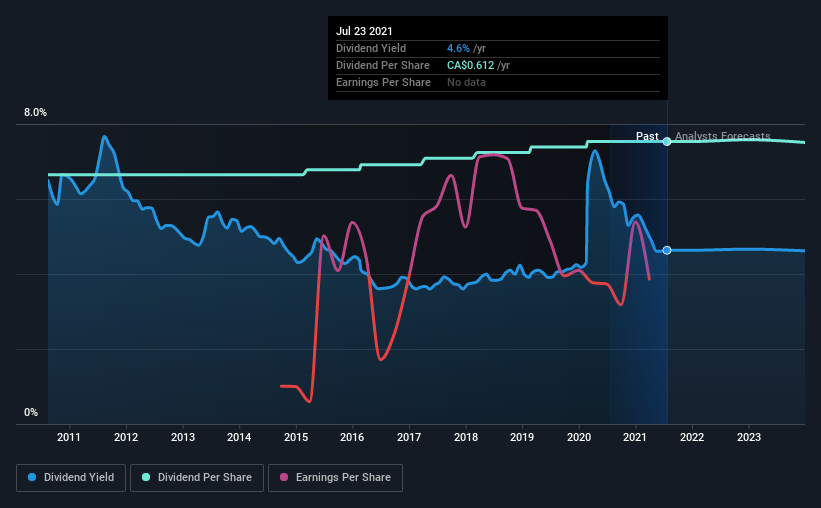Don't Buy Chartwell Retirement Residences (TSE:CSH.UN) For Its Next Dividend Without Doing These Checks
Regular readers will know that we love our dividends at Simply Wall St, which is why it's exciting to see Chartwell Retirement Residences (TSE:CSH.UN) is about to trade ex-dividend in the next four days. The ex-dividend date is one business day before the record date, which is the cut-off date for shareholders to be present on the company's books to be eligible for a dividend payment. The ex-dividend date is important as the process of settlement involves two full business days. So if you miss that date, you would not show up on the company's books on the record date. Meaning, you will need to purchase Chartwell Retirement Residences' shares before the 29th of July to receive the dividend, which will be paid on the 16th of August.
The company's next dividend payment will be CA$0.051 per share. Last year, in total, the company distributed CA$0.61 to shareholders. Calculating the last year's worth of payments shows that Chartwell Retirement Residences has a trailing yield of 4.6% on the current share price of CA$13.21. We love seeing companies pay a dividend, but it's also important to be sure that laying the golden eggs isn't going to kill our golden goose! We need to see whether the dividend is covered by earnings and if it's growing.
Check out our latest analysis for Chartwell Retirement Residences
Dividends are typically paid out of company income, so if a company pays out more than it earned, its dividend is usually at a higher risk of being cut. Chartwell Retirement Residences reported a loss after tax last year, which means it's paying a dividend despite being unprofitable. While this might be a one-off event, this is unlikely to be sustainable in the long term. With the recent loss, it's important to check if the business generated enough cash to pay its dividend. If cash earnings don't cover the dividend, the company would have to pay dividends out of cash in the bank, or by borrowing money, neither of which is long-term sustainable. Over the last year, it paid out more than three-quarters (78%) of its free cash flow generated, which is fairly high and may be starting to limit reinvestment in the business.
Click here to see the company's payout ratio, plus analyst estimates of its future dividends.
Have Earnings And Dividends Been Growing?
Companies that aren't growing their earnings can still be valuable, but it is even more important to assess the sustainability of the dividend if it looks like the company will struggle to grow. If earnings decline and the company is forced to cut its dividend, investors could watch the value of their investment go up in smoke. Chartwell Retirement Residences was unprofitable last year and, unfortunately, the general trend suggests its earnings have been in decline over the last five years, making us wonder if the dividend is sustainable at all.
Many investors will assess a company's dividend performance by evaluating how much the dividend payments have changed over time. Chartwell Retirement Residences has delivered an average of 1.3% per year annual increase in its dividend, based on the past 10 years of dividend payments.
We update our analysis on Chartwell Retirement Residences every 24 hours, so you can always get the latest insights on its financial health, here.
To Sum It Up
Should investors buy Chartwell Retirement Residences for the upcoming dividend? It's hard to get used to Chartwell Retirement Residences paying a dividend despite reporting a loss over the past year. At least the dividend was covered by free cash flow, however. It's not that we think Chartwell Retirement Residences is a bad company, but these characteristics don't generally lead to outstanding dividend performance.
Although, if you're still interested in Chartwell Retirement Residences and want to know more, you'll find it very useful to know what risks this stock faces. For instance, we've identified 3 warning signs for Chartwell Retirement Residences (2 are potentially serious) you should be aware of.
We wouldn't recommend just buying the first dividend stock you see, though. Here's a list of interesting dividend stocks with a greater than 2% yield and an upcoming dividend.
This article by Simply Wall St is general in nature. It does not constitute a recommendation to buy or sell any stock, and does not take account of your objectives, or your financial situation. We aim to bring you long-term focused analysis driven by fundamental data. Note that our analysis may not factor in the latest price-sensitive company announcements or qualitative material. Simply Wall St has no position in any stocks mentioned.
Have feedback on this article? Concerned about the content? Get in touch with us directly. Alternatively, email editorial-team (at) simplywallst.com.


